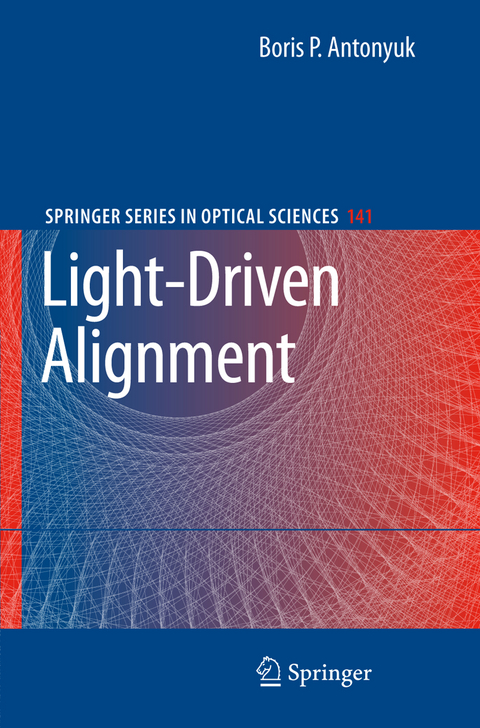
Light-Driven Alignment
Seiten
2010
|
1. Softcover reprint of hardcover 1st ed. 2009
Springer Berlin (Verlag)
978-3-642-08933-6 (ISBN)
Springer Berlin (Verlag)
978-3-642-08933-6 (ISBN)
Light is now a tool: it can be used to control electron transport to influence the properties of solids, thereby opening new ways to produce materials. This book presents the theoretical bases of these processes as well as optical motors.
This book discusses how, in random media, light dramatically changes electron- electron interaction. Despite Coulomb repulsion, the effective interaction dem- strates attraction, even under strong pumping. Light (both coherent and natural) acts like an optical motor, transporting electrons in a direction opposite to that of the electric force direction: electric current ?ows against bias and static polarization is aligned in opposition to the applied electric ?eld. The uncommon electron transport increases the initial perturbations and is the foundation of the light-driven struct- ing of a matter. This structuring belongs to the class of self-organization phenomena of open dissipative systems and exhibits a number of fascinating properties. Light pushes electrons into spatially ordered macroscopic bunches observed in fused silica under ArF-laser irradiation. It carves material balls with ?xed diameters equal to 2 microns and throws them out of the ablation crater. Moderate light int- sity drills material, forming long channels that align with the wave vector and drill diameters can be as small as 2 microns, while the beam spot is a few millimeters. Bicolor excitation causes orientational ordering in random media. We monitored the induced transformation by measuring the emerged second harmonic signal. The orientational ordering has been used for all optical poling of glasses. Light tre- ment prepares phase-matched grating of second-order nonlinear susceptibility and provides effective second harmonic generation. All optical poling was performed in bulk materials and ?bers.
This book discusses how, in random media, light dramatically changes electron- electron interaction. Despite Coulomb repulsion, the effective interaction dem- strates attraction, even under strong pumping. Light (both coherent and natural) acts like an optical motor, transporting electrons in a direction opposite to that of the electric force direction: electric current ?ows against bias and static polarization is aligned in opposition to the applied electric ?eld. The uncommon electron transport increases the initial perturbations and is the foundation of the light-driven struct- ing of a matter. This structuring belongs to the class of self-organization phenomena of open dissipative systems and exhibits a number of fascinating properties. Light pushes electrons into spatially ordered macroscopic bunches observed in fused silica under ArF-laser irradiation. It carves material balls with ?xed diameters equal to 2 microns and throws them out of the ablation crater. Moderate light int- sity drills material, forming long channels that align with the wave vector and drill diameters can be as small as 2 microns, while the beam spot is a few millimeters. Bicolor excitation causes orientational ordering in random media. We monitored the induced transformation by measuring the emerged second harmonic signal. The orientational ordering has been used for all optical poling of glasses. Light tre- ment prepares phase-matched grating of second-order nonlinear susceptibility and provides effective second harmonic generation. All optical poling was performed in bulk materials and ?bers.
Light-Driven Ordering: Theory.- Domain Charge Structure of Amorphous Semiconductor.- Light-Driven Spatial Ordering in Random Media.- Light-Driven Orientational Ordering in Random Media.- Self-Organization in Ge-Doped Silica Fibers and Second Harmonic Generation.- Optical Motor: Toward the Model of Life Emerging on Earth.- Electron Acceleration by Petawatt Light Pulses.- Light-Driven Temporal Self-Organization.- Light-Driven Bistability of Molecular Crystals.- Charge Transfer Excitons in Soft Matter.
| Erscheint lt. Verlag | 22.11.2010 |
|---|---|
| Reihe/Serie | Springer Series in Optical Sciences |
| Zusatzinfo | X, 244 p. 119 illus. |
| Verlagsort | Berlin |
| Sprache | englisch |
| Maße | 155 x 235 mm |
| Gewicht | 390 g |
| Themenwelt | Naturwissenschaften ► Physik / Astronomie ► Optik |
| Technik ► Elektrotechnik / Energietechnik | |
| Schlagworte | Elektronen • Exciton • Glass • Laser • Optical motors • Self-ordering • Self-Organization • semiconductor |
| ISBN-10 | 3-642-08933-X / 364208933X |
| ISBN-13 | 978-3-642-08933-6 / 9783642089336 |
| Zustand | Neuware |
| Haben Sie eine Frage zum Produkt? |
Mehr entdecken
aus dem Bereich
aus dem Bereich
Grundlagen - Verfahren - Anwendungen - Beispiele
Buch | Hardcover (2022)
Hanser, Carl (Verlag)
49,99 €
Grundlagen und Anwendungen
Buch | Hardcover (2023)
Hanser, Carl (Verlag)
59,99 €


